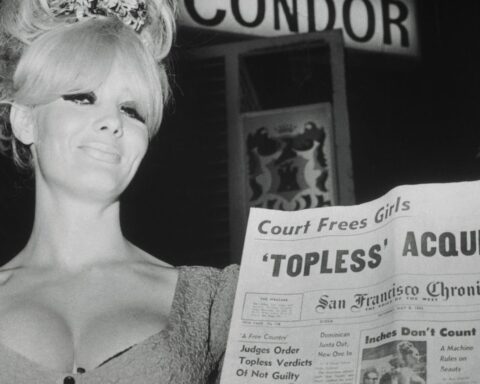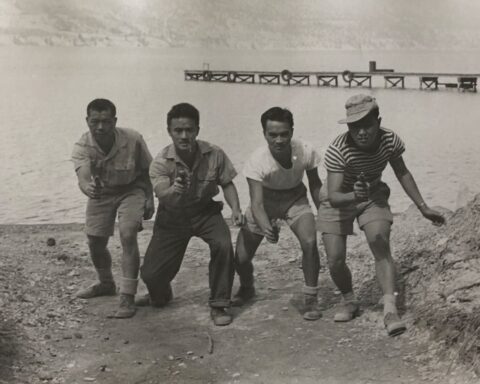Brett Gaylor says he knew from the get-go that it was a ludicrous challenge. The Montreal-based filmmaker was constantly intrigued by what the digital revolution was doing to the notion of intellectual property and copyright laws. He concedes his fascination bordered on obsession. “It was on my mind a lot,” he recalls. “But then it was just something I was tossing around in my head. I mean, it seemed like the ultimate unfilmable subject.”
But Gaylor could see that the debates regarding the online sampling of music by mash-up artists and the new Internet vehicle of music distribution was going to continue for some time—and remain highly contentious as well. After deep-frying the music industry, Internet distribution is now being cited as one of the accelerating factors of the already-dire meltdown of daily newspapers and the rest of the print media, and causing severe heartburn among film producers and the movie studios.
Gaylor was also acutely aware that addressing such issues in documentary form could result in the driest, dullest movie experience in years, bogged down by the language of legalese. “I had to find characters I could follow through this. I had to tell the stories in a visual way. How are some of these copyright and patent issues interrelated? What is the connection between developing an AIDS vaccine and music sampling? How are we going to think about property now? It’s been irrevocably changed. How do we face that?”
Gaylor quickly got Daniel Cross, the filmmaker and cofounder of EyeSteelFilm, on board; they’d met when Gaylor was doing his film degree at Concordia University, where Cross teaches. EyeSteelFilm and the NFB agreed to coproduce Gaylor’s doc feature on copyright law and intellectual property in the digital age. The same duo produced Up the Yangtze, one of the biggest doc successes of the past decade, undoubtedly a good indication of RiP’s audience possibilities.
The result is RiP: a Remix Manifesto, Gaylor’s exhaustive, invigorating exploration of art, ownership, residuals and the mayhem invoked by the wonders of the Internet revolution. Gaylor could see that, in many respects, the music industry was the first to deal with the brave and often unsettling new world of Internet distribution, when the cost of downloading a song could be reduced to virtually nothing. While some have discussed and written about RiP as a film about copyright vs. copyleft, Gaylor knows this debate is far less about a binary opposition and more like a pretzel: it is Byzantine in its complexity.
What RiP does do is bring these issues to life in an invigorating, fascinating way. Each sequence raises questions about our collective notions of intellectual property, rights and residuals—forcing us to think and rethink our positions on each issue. At times, it’s stimulating to the point of almost being exhausting. It’s one of those documentaries that demands multiple screenings—which is fitting, given that Gaylor says the debate is so fluid and amorphous. “I got lost in some of the questions I was raising,” Gaylor says, of the complex process of making RiP.
And in the spirit of interactivity, those behind RiP invited Internet participation while they were creating the feature. People were asked to log on to RiP’s website where they could suggest edits for the work-in-progress, making the doc a tribute to the spirit of the mash-up. And Gaylor confirms that some of the ideas floated by those surfing the site made their way into the final cut.
Gaylor makes the obvious nod to Andy Warhol, whose brazenly postmodern work generated questions as it unapologetically lifted images from classical art and pop culture—witness his overlapping of the Mona Lisa with the Pepsi logo. But Warhol himself referred to this as outright theft.
Gaylor revisits some complex cases that question the fair use of older cultural material. Who stole what in the following story? In the ’60s, the Rolling Stones enjoyed one of their biggest successes with the single “The Last Time.” Mick Jagger and Keith Richards relied heavily on a gospel song by the Staple Singers while concocting their hit. Their agent, Andrew Loog Oldham, recorded his own orchestrated version of their song. Three decades later, the Verve sampled bits and pieces of Oldham’s rendition for what would become their biggest hit, “Bitter Sweet Symphony.” Jagger and Richards’ publishing company successfully sued the Verve for copyright infringement, effectively gaining all money made by the Verve from the song. Jagger and Richards made even more money by selling the Verve version of the song to the Nike brand for an advertising campaign.
And Gaylor revisits the case of artist Dan O’Neill, who drew and wrote a series of radical cartoons in the ’70s, telling his own bizarre, arguably satirical, variation of the story of Mickey Mouse. The Disney Corp was not amused, and took O’Neill all the way to the Supreme Court—which ruled that Disney was in the right and admonished O’Neill for drawing his own rendition of the celebrity rodent.
This in turn triggers another intriguing dimension to RiP and the arguments Gaylor is addressing. While the Disney Corp has been among the most fervent in its protectionist policies over its various properties, Walt Disney himself was the ultimate mash-up artist, a man who lifted and appropriated all sorts of ideas from earlier artistic works, ranging from Alice in Wonderland to Buster Keaton’s Steamboat Bill, Jr., reshaping them into his own polished cultural products.
While there is nuance in Gaylor’s epic, sprawling rendering of these debates, he clearly leans away from the copyright capitalists and towards the copyleft activists. His manifesto is laid out in RiP: “Number one: Creativity always builds on the past. Number two: The past will always try to control the future. Number three: Our future is becoming less free. Number four: To build something free, you must limit control of the past.”
This has led some to contend that Gaylor has leaned too far in one direction in terms of the copyright-vs.-copyleft debate, obviously favouring those who want to dump virtually all of the laws surrounding intellectual property.
Patricia Aufderheide, the director of American University’s Center for Social what Gaylor says in the film, she sees it as an oversimplification of the issues at hand. “The situation in Canada is much different than in the US, of course. Your laws tend to be more restrictive—but many of the examples Brett is using are American. What we need more of is education. Because in fact, many of the things that artists and filmmakers want to do, they are entirely permissible under the rubric of fair use. I don’t think the problem is that bad in the US. And I think the film overplays that fear.”
Aufderheide, who is an expert in copyright law, also says that RiP conflates different kinds of legal issues, creating confusion and fear where it’s unnecessary. “Copyright, patent and trademark are all different areas of the law.” And, she adds, “An artist sampling some music to comment on it or create new art is one thing, while people illegally downloading songs for free is something entirely different. One is exercising your right to fair use and free speech. The other is theft. Let’s not confuse them.”
Kirwan Cox, a Montreal-based author and university instructor who worked as a researcher on RiP, defends Gaylor’s vision, arguing that if anything has taken a hit over the past decade, it’s been the idea of fair use. The mash-up artists, he contends, are clearly at a disadvantage when faced with massive multinational corporations. “There has been a contraction in the original idea of copyright fair use and fair dealing by government, especially in the US, in response to pressure from big intellectual property business. We all wait for the day when Mickey Mouse goes into public domain, as he should have done years ago, instead of being protected by legislation [which kept the Mouse in the private hands of Disney decades longer than previously determined] proving the power of these interests.”
Cox says the rapid growth of the Internet means new contracts need to be ironed out regarding who owns what. But he also defends the bent of this point-of-view doc. “A balance needs to be found between users and producers. Most doc filmmakers identify as users—I found this out from a DOC survey I did a few years ago. RiP may go a little far in one direction, but it is moving the pendulum, which had gone way too far in the other direction. I think RiP has done a great job of taking an impossible complex and dry subject and making it entertaining. Brett is trying to find alternative copyleft business models for his film, so he is making an interesting experiment. It may not work for everyone, but he hasn’t been afraid to try.”
Not surprisingly, Gaylor agrees. But he also says the charge that he’s simplifying things is one he agrees with. “Simplifying the issues is actually important—cutting through the devil’s advocacy and mind-numbing details to express the debate surrounding intellectual property as a basic moral issue.” And he insists that some copyright protection is fair and entirely justifiable: “This doesn’t mean that everything should be free. The film doesn’t advocate for that, it advocates for a re-balancing of copyright. Copyright was always meant to be a balance of the public’s right of access to information against the need to [provide] incentive [for] artists to create.
“What I’m trying to say with the film is that this balance is gone. For too long, the only voices in this debate have been corporations with a vested interest in the most restrictive copyright laws possible, those who’ve had a monopoly on how this issue was framed. So it was important for me to come out strong, say what I had to say, and create debate. We knew there would be those who reacted strongly for and against the film for that reason.
“This film is more about raising questions than pretending that I have every solution. How is the new economy going to work? Hybrids seem to work—I don’t think everything should be for free. Some rights are reserved. But I don’t think someone should be prevented from remixing some music. ‘All rights reserved’ prevents that. What’s the harm from someone remixing your work? It could be argued that enhances the value of your work if someone’s doing that.”
And Gaylor points out that he never attempted to throw up any false guise of objectivity. “The goal was never “fair and balanced.” It’s a manifesto. So yes, I’ve picked my side—I think the audience knows that.”
RiP does achieve the documentary sublime when Gaylor manages to successfully connect a series of copyright issues—from music downloading to AIDS medication patents to the actual patenting of newly developed species (something the US Supreme Court ruled was okay, arguably the creepiest factoid in the entire doc). That puts the entire debate over ownership of concepts into the realm of a downright chilling sci-fi movie. There’s a tremendous scene of liberation in the film, as Brazilians dance in euphoria over their government’s decision to break the patent laws over an AIDS medication—patents that protected the pharmaceutical companies that owned them, but that kept drugs out of the price range of the poor who most desperately needed them. While poor Brazilians danced over this act of life, Gaylor tells us in voiceover, the pharmaceutical companies viewed the government action as an act of war.
“Pop culture has never asked our permission to be placed in our lives. The mass media machine gets to put it everywhere. The idea that we’re supposed to ask permission to sample that work, to critique and recontextualize it. That is the core statement I was trying to make. It’s a real puzzle. We live in this universe where we’re constantly being pushed to buy something, or vote for someone. I think it’s the ultimate literacy to be able to take that and recontextualize it—to say, I won’t be sold this, I won’t vote for that. I have my own statement to make.
“We should never have to ask permission to do that. That would simply be wrong.”











